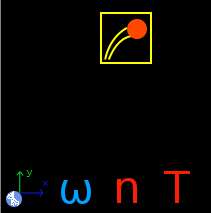Next: Example 4, Previous: Example 2, Up: Examples circular kinematics of particles [Contents][Index]
5.3 Example 3
A mobile with uniform circular motion describes a circle of radius 7.5 m. If the angular velocity is 1.3 rad/s, How seconds need to describe 9 laps? What is the centripetal acceleration? What is its period?
Solution with FisicaLab
Select the Kinematic group and, inside this, the Particles circular module. Erase the content of the chalkboard and select the SI system. Now add one element Mobile with circular motion, one element Angular velocity, one element Number of laps, one element Period and one element Stationary reference system. As show the image below:

The time is an unknown data, then to the element Stationary reference system:
- tf
t
To the element Mobile with circular motion, gonna be called Mobile, the initial and final velocity are unknown data. Also the centripetal acceleration at initial and end time are unknown data:
- Name
Mobile
- C
0
- r
7.5
- aci
0
- at
0
- angi
0
- vi
vi
- ti
0
- angf
angf
- vf
vf
- acf
acf
In the element Angular velocity, the value 1.3 rad/s, is the constant angular velocity of our Mobile, because this have a tangential acceleration equal to 0. However, to comply with number of equations = number of unknown data, we put this data as initial angular velocity and leave the final data as unknown, although it has the same value:
- Object
Mobile
- vangi
1.3
- vangf
vangf
To the element Number of laps:
- Object
Mobile
- n
9
And to the element Period:
- Object
Mobile
- T
T
Now click in the icon Solve to get the answer:
aci = 12.675 m/s2 ; vi = 9.750 m/s ; angf = 360.000 degrees ; vf = 9.750 m/s ; acf = 12.675 m/s2 ; t = 43.499 s ; vangf = 1.300 rad/s ; T = 4.833 1/hz ; Status = success.